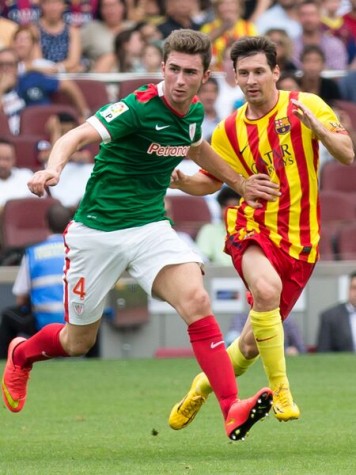Spanish League Not A Dance For Two Anymore

Lluis from Sabadell (Barcelona, Spain) via Wikimedia Commons
Barcelona, along with their striker, Leo Messi, will look to repeat the championship season they had.
August 22, 2015
European football will be back in full swing with the Spanish “Liga” set to kick off at the end of the month.
Many sports commentators and enthusiasts argue that the two biggest clubs, Real Madrid and Barcelona, dominate the Spanish league. While that may have been true eight to 10 years ago, today there is a bigger playing field than just these two teams. No longer is it just Real Madrid and Barcelona, now there is Atletico de Madrid, Sevilla, Villareal, Valencia, and Athletic Bilbao to name a few.
One example of the leveled playing field is the recent European competitions. Arguably, the most impressive team has been Sevilla. They won the Europa League Championship back to back in 2006 and 2007. Then, they won the championship once again in the 2014 and 2015 seasons. It is also noteworthy to mention that Atletico de Madrid also won the Europa League in 2010 and 2012.
On an international popularity platform, it may seem as though the only two teams that exist in La Liga continue be Real Madrid and Barcelona. However, other teams have been acquiring greater talent, thanks in part to investors who have purchased partial or full ownership of these teams. The financial support from the investors, marketing strategies, and the homegrown talent in youth leagues has revitalized the quality of competition from smaller teams in La Liga. Thus, no longer making it a two-team competition.
While on a financial level some teams cannot compete against the bigger teams in the Spanish league, they aim to make it into the top 10 of the table. From there, only the top six qualify for European competitions, such as Champions League and Europa League, the following season. Qualifying to European competitions means more revenue from television rights, and other monetary prizes awarded from sponsorships, UEFA and the Liga Nacional de Fútbol Profesional (LFP).
The first half of the season has potential to be interesting for the bigger teams.
Barcelona, the reigning champions are amid a player “signing” ban and will start the first half of the season without any new acquisitions to their club. They look to continue their reign at the top of the table and perhaps grow stronger once their new players see minutes on the field during the second half of the season.
During the offseason, Real Madrid hired a new coach, Rafa Benitez, and had a modest summer transfer activity. It’s considered modest because they haven’t signed any big name player, as they usually do.
The departure to Porto of long-time team captain and goalkeeper, Iker Casillas left the goalkeeping duties to Keylor Navas and Kiko Casilla. Both are excellent goalkeepers that can provide much-needed defense under the goalposts. Real Madrid spent their summer, playing matches against other clubs that helped them adapt to the coaching style of Benitez. If they can use that momentum in the Liga, they can have a great start to their season.
Atletico de Madrid, a team among the top three had the most activity this offseason. Atletico will look to regain the form they had during the 2014/15 season, where they won the league. It will be difficult for a team to replace the key players such as Turan (Barcelona) and Mandzukic (Juventus) who departed from the team. Sevilla, Valencia and Villareal have also had several players come and go this offseason. On paper, these teams all have what it takes to put up a fight for the top places in the standings.
Like any other sport, football is completely unpredictable. The only certainty is that two teams no longer dominate the Spanish league. It is well rounded and sure to make for an exciting season. It’ll only take 38 weeks to find out who can manage to win it all.







